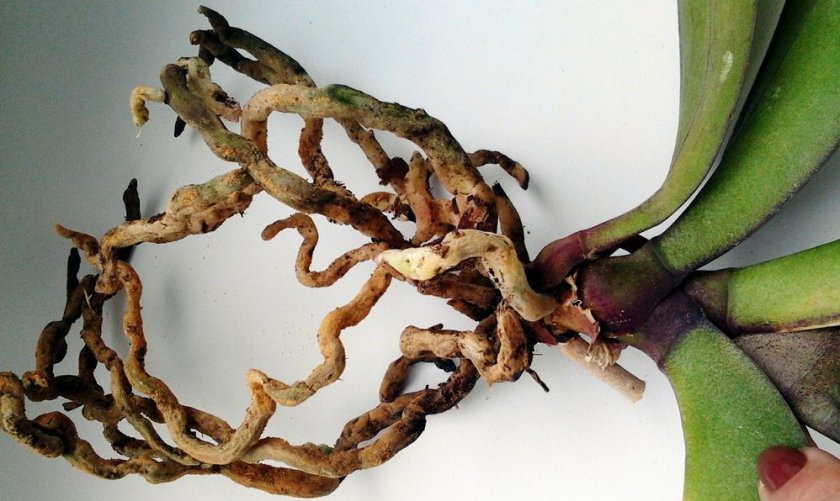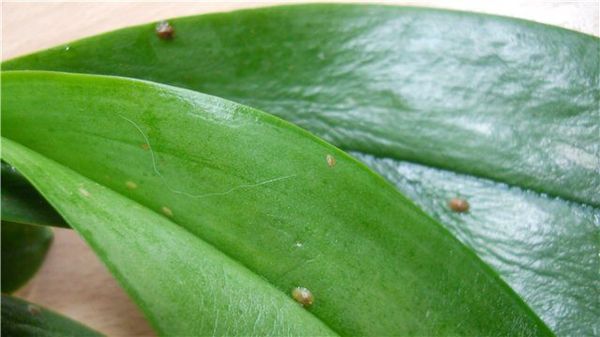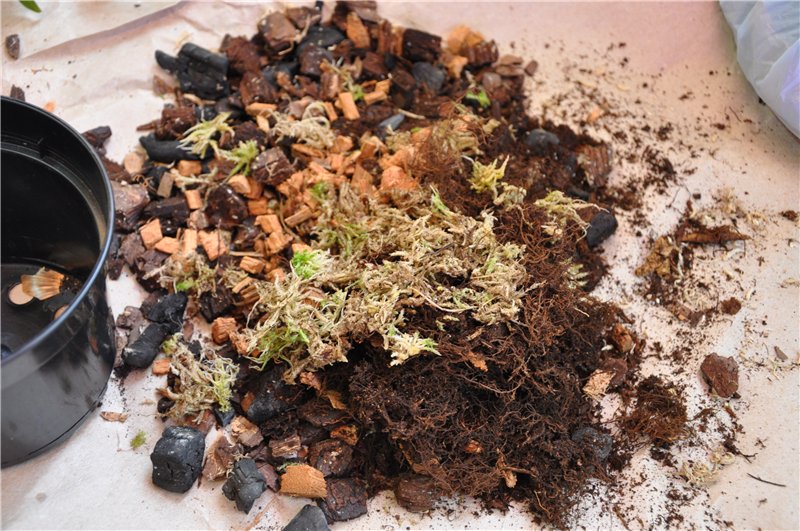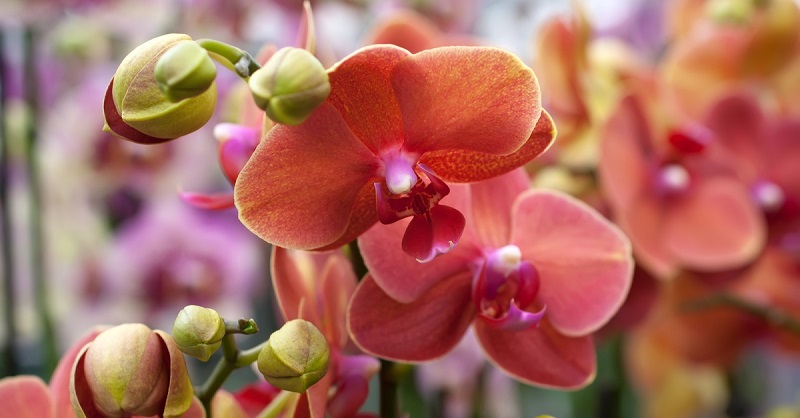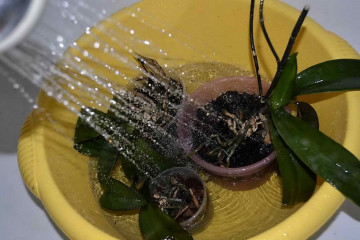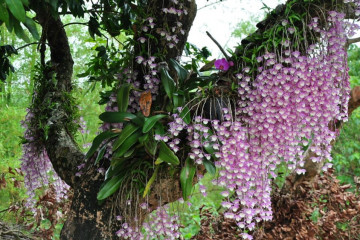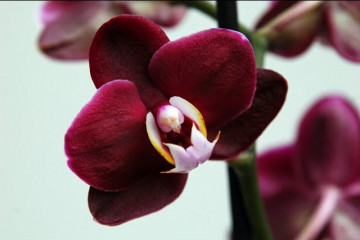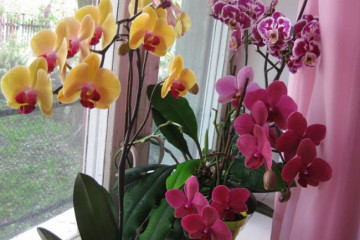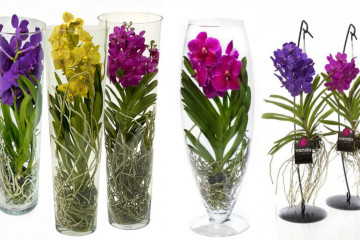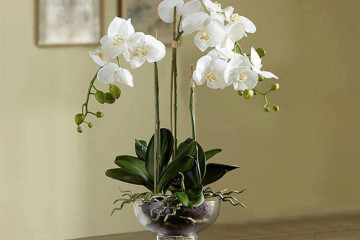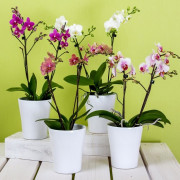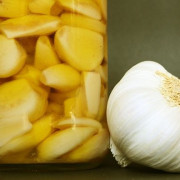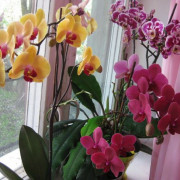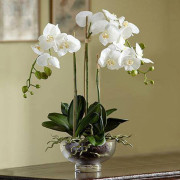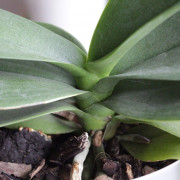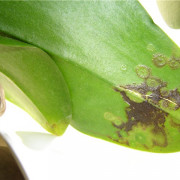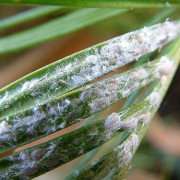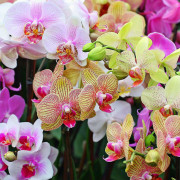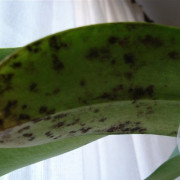Is it possible to transplant a blooming orchid: the number of times and the need for the procedure
Content:
More than 35 thousand species of orchids are known. From the Greek language "orchid" is translated as "similar to a butterfly." It is a beautiful tropical flower that does not require any complicated maintenance. Phalaenopsis is the most common type for growing at home. With proper care, it can bloom almost all year long. Like many indoor plants, orchids need replanting. But it is important to know if an orchid can be transplanted during flowering.
Transplant reasons
Every 2-3 years, a home orchid needs a change of substrate and pot. But there are situations when it is impossible to hesitate with a transplant, since the plant may die. So, what reasons can affect the time of flower transplantation:
Putrefaction
Even if the plant looks healthy at first glance, this is not an indicator that everything is in order with the root system. Due to the fact that orchids are mainly planted in transparent pots, it is not difficult to observe the condition of the roots.
The fact that rotting develops can be seen from the state of the flower itself:
- leaves and flower slow down development or stop developing altogether;
- leaves begin to change their color, turn yellow;
- brown spots appear on the leaves;
- flowers and buds begin to wither and crumble.
The root decay process begins because the flower is often watered. For healthy functioning, the roots need to dry out before the next watering. Lighting also affects. With a lack of it, the plant will not absorb the necessary moisture. If the substrate is too dense or of poor quality, this entails insufficient air penetration to the roots, from which the root system "suffocates".
Pests
There are several types of pests that can reproduce indoors on indoor plants:
- mealy and root bugs;
- aphid;
- thrips;
- shield and false shield;
- whitefly;
- spider mites and flat beetles;
- mushroom gnats.
One of the most difficult parasites to remove is the mealybug. This insect looks like a gray fluff 5 mm in size. Adult females or larvae are harmful. They pierce the plant and draw nutrients out of it. When pierced, enzymes enter the plant, which negatively affect the metabolic processes of the plant. When infected, the plant becomes susceptible to any infection.
The root worm is 2-4 mm in size, light gray or yellowish. This pest can damage both the root system and the aerial part. It feeds on orchid juice. When damaged by this pest, the plant begins to weaken abruptly.
Aphids are easily visible on the plant. She is very small and reproduces quickly. There are aphids that are light yellow or green. It can settle on any part of the flower. It pierces the top layer of the plant and feeds on the cell sap.
If small black dots and uneven small grooves are noticeable on the orchid leaves, it means that thrips have affected the plant. These are especially persistent parasites that settle on the leaves or in the flowers of the orchid.They are very small and have wings, with which they can fly from one plant to another, spreading various diseases.
The scale or false scale usually appears on twigs or trunks. These parasites suck out the juice, while releasing a sticky substance. It clogs the pores of the plant, making it difficult for the orchid to breathe and develop. When infected with these parasites, orchid leaves begin to turn yellow and fall off.
The whitefly is a small insect with a length of 1 mm or more, with light wings. It sucks sap from plant tissues. Yellowish streaks and sugary nectar remain on the surface of the leaves. The flower weakens and stops developing.
The most common plant parasite is the spider mite. Most often, it appears where there are indoor roses. If the plant has white dots and a thin web, then it is infected with ticks. Bites and a silvery bloom appear on the back of the leaf.
Root system problems
Orchid root system diseases are divided into three categories:
- viral. In this case, the entire plant is affected. Their root system is covered with spots or stripes;
- bacterial. With such a disease, ulcers appear on the root system with fluid escaping from them;
- fungal. In the case of such diseases, the roots are covered with a yellow or pink bloom.
The transplant process at home
An important question asked by novice growers: is it possible to transplant a blooming orchid? The phalaenopsis orchid does not have a clear dormant period. It has a constant growth process: either leaves grow, or flowering occurs.
The most favorable time for transplanting is spring. But sometimes there are circumstances, for example, a plant disease, in which an urgent transplant is required, regardless of whether the orchid is blooming or not. Can an orchid be transplanted during flowering? You can, if you do not violate the root system.
Watering
In order to meet all the necessary moisture conditions, you need to understand the following:
- if you transplant a flower without damaging and cleaning the roots, without changing the soil, just in a new pot, the orchid practically does not notice this change, does not stop blooming. You can continue watering, according to the needs of the plant, according to the old scheme;
- when a transplant is done with pruning damaged roots, changing soil, a special irrigation regime is required.
Immediately after transplanting, you can water the flower if the new soil requires it. If the soil is old and was initially wet, you should not be zealous with watering, it is better to wait 4-5 days for it to dry well. If you transplant a plant in the summer, then the first watering should be done after 24 hours, if you transplant an orchid in winter, after 2-4 days.
Choice of capacity
The further health of this plant depends on the correct choice of a pot for an orchid. Air and lighting must flow to the root system of this flower, this should be taken into account first of all. The roots should not grow on the walls of the container.
What should be the correct orchid pot:
- there should be a large number of drainage holes at the bottom of the pot. Excess irrigation water will flow through them, as well as ventilation of the roots. If there are few holes in the pot you like, you can drill them yourself;
- for transplanting an orchid, you should choose a pot that is a couple of centimeters larger than the previous one. There should be 3-5 cm of drainage at the bottom of the pot;
- you should not choose too large containers, since all the power of the plant will be directed to the root system in order to fill the entire pot. Such an orchid will bloom extremely rarely. And also in large containers, the substrate will dry out longer, which can lead to rotting of the roots.
Transplant soil
Orchid is a tropical plant that parasitizes trees. It will not grow in normal soil. For a flower to grow properly, an appropriate substrate is required. The stores sell special mixtures that include bark. Additional ingredients such as moss, charcoal and fern roots can also be added.
The main indicator of the correct soil for an orchid is its looseness. It must be well ventilated. The bark should not be too large, but not too small. A small substrate will not allow air to pass through well and dry out for a long time, which can damage the roots of the plant.
You can prepare the soil for the flower yourself. This requires:
- Collect pine bark from fallen trees.
- Rinse it well with running water.
- Crumble into 1.5-6 cm pieces using a pruning shear.
- Boil for a few minutes. This is for disinfection.
- After boiling, rinse again and boil again.
- Dry it, but not completely.
Orchid bloom
Most often, an orchid enters the house precisely during flowering. The time when the orchid blooms and the number of flowers in the phalaenopsis orchid may be different. The color scheme is very diverse. The flower can be either solid or with colored veins or spots.
How often it blooms
The flowering frequency of an orchid depends on the age of the plant. The very young are unable to form peduncles. But if the plant is already 1.5-2 years old, it must bloom. The number of leaves also affects the flowering of an orchid. If she has already formed 5-6 strong leaves, she is quite ready for the formation of buds.
There are moments of calm when the orchid does not want to please with its beautiful flowers. If this period is delayed, you can "shock" the plant, for example, move the pot to a new place. This will stimulate the growth and development of the flower.
How long
With proper care and a favorable environment, an orchid can bloom for several months. Some species of this flower are capable of blooming for six months.
The flowering of an orchid begins from the moment the bud opens. After it has fully opened, the flower continues to grow and grow for another couple of days. All buds open gradually.
When the plant sheds its first flowers, some of the buds may not yet open or be in the process. Thus, the orchid blooms for a long time.
As a rule, the buds that are closer to the end of the peduncle begin to bloom first. It takes 1-2 days for the flower to fully unfold. Under the weight of buds and flowers, the peduncle can break, to avoid this, you need to stick a plastic or wooden stick into the pot and attach the peduncle to it.
Further care of the flower
After the flower is transplanted, it must be placed in a cool place, which is protected from drafts and sunlight.The most favorable air temperature for a transplanted plant is 20-22 ° C. Without the need, you should not rearrange the pot at least for the first time, 10 days. Then the orchid needs to be looked after as usual.
The temperature regime, illumination, and air humidity should not be allowed to change dramatically. You can use different methods of watering, such as: shower, watering, watering can or spraying. In winter and autumn, the flower should be watered once a week, in spring and summer - twice every 10 days.
Thus, an orchid transplant is an elementary procedure, during which some nuances should be taken into account. And after that, the main thing is to provide decent care. Only then will the flower delight with long flowering.

